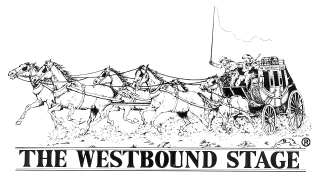

OUR WELLS FARGO MUSEUM
|
Welcome to our Wells Fargo & Co.'s Express Museum.
|
If you need information about an item, and you do not find it here, please contact us at
951-404-3069
or
[email protected].
We trust that you will find your visit here pleasant and rewarding.
Advertisements:
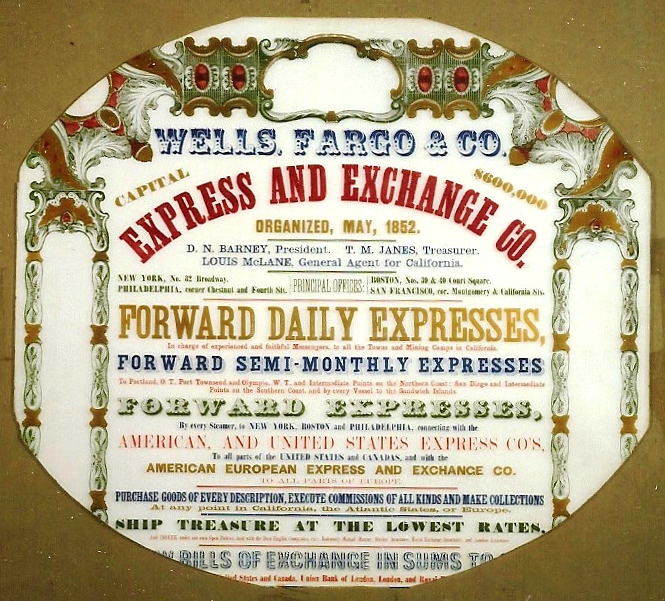 Advertising, in its many forms, played a major role in the express business from the earliest days. The company devoted considerable attention to
Signs, "Call Cards," and newspaper advertisements. The natural expansion of business depended upon the company's reputation, of course. But first,
it was necessary to publicize whatever services were being offered.
Advertising, in its many forms, played a major role in the express business from the earliest days. The company devoted considerable attention to
Signs, "Call Cards," and newspaper advertisements. The natural expansion of business depended upon the company's reputation, of course. But first,
it was necessary to publicize whatever services were being offered.
In this case, "Express and Exchange" services are being offered. The miner wanted money for his gold dust, but pretty soon, the company would run
out of money. So, the company offered the miner a "Bill of Exchange" to send money to his wife and family back home.
The miner would pay for the Bill with his gold dust, and the company would send the gold dust and the Bill to an "Exchange Bank" back East. That way,
Wells Fargo & Co. would not run out of money. The miner's wife could then go to the bank and withdraw the money, while the gold dust would be shipped
to the U.S. Mint for coining. Other Wells Fargo & Co. advertisements offered Travelers Money Orders, U.S. Mail franks, and Express Franks.
Agency Appointments:
Each Wells Fargo & Co. office was run by a company-appointed Agent. The company was constantly seeking
trustworthy people to fill these positions.
Prominent and successful storekeepers, attorneys, and other community leaders frequently were asked to represent the interests of the company
in their own home town, or to travel to a remote mining camp and open a new Office.
The appointment certificate or letter was displayed publicly, in laudable recognition of the company's trust in the individual. To be appointed an agent
frequently ensured the person a prominent position in the community.
The photos show agent Oscar C. Hacker and his secretary, Marie Hicks, at their Dayton, Ohio office, which had just been rebuilt following the destruction
of the flood of 1913. Note the water damage to the door and building foundation. Hacker passed away in 1918, a victim of the Spanish Influenza.
Bags:
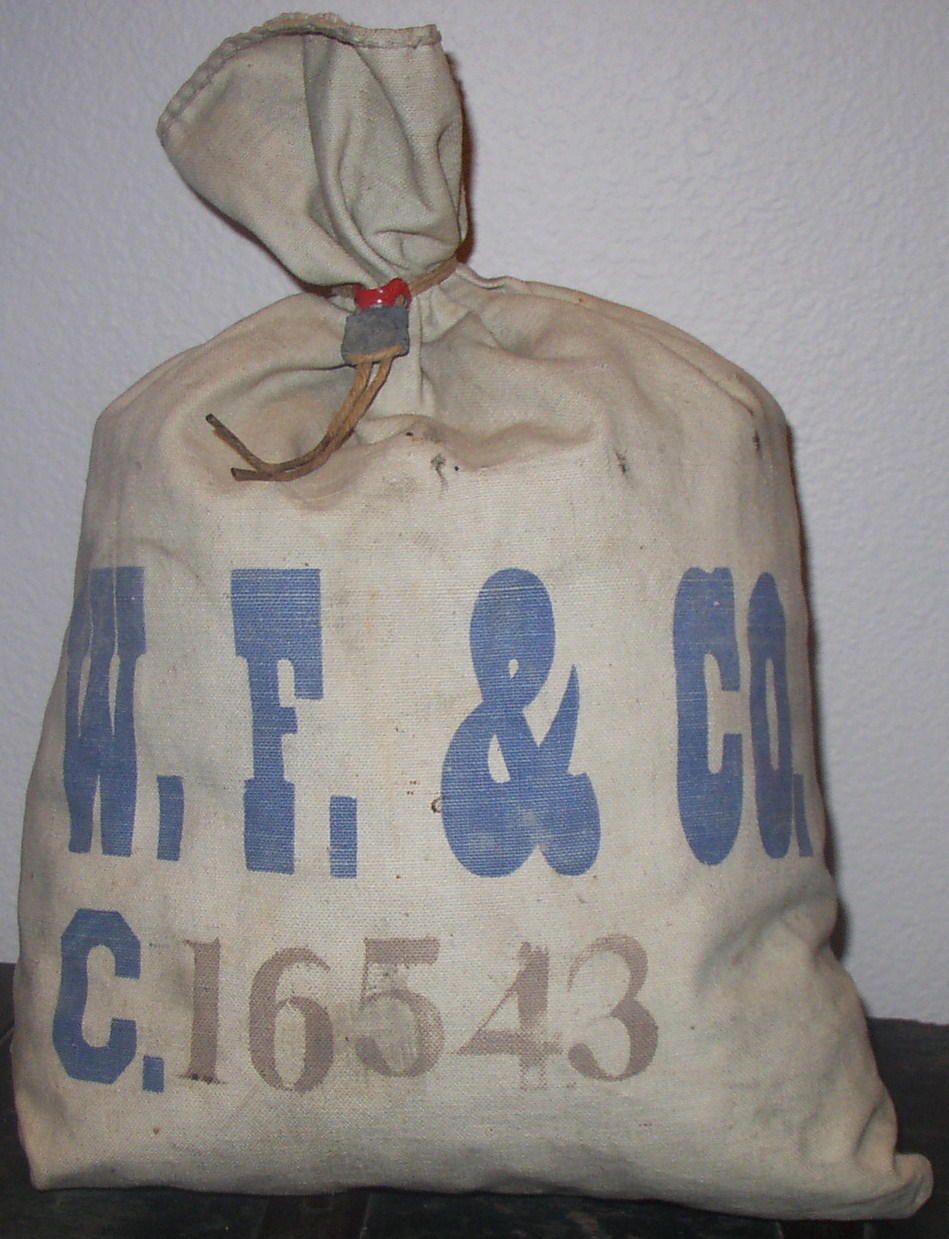
This Coin Bag is one of several kinds of bags that Messengers used when dealing with local merchants. It shows a Lead and Twine seal that was
applied with a Porter Bag Sealer.
Most of the Coin Bags were made of very heavy canvas, and some were reinforced with leather.
Besides coin bags, the company used Bullion bags, Grip bags, Kit bags, Nose bags, and Parcel bags.
Books:
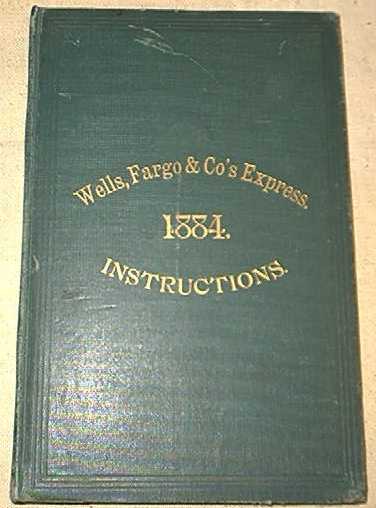 Perhaps the most important book was the Instruction Book. This book spelled out, in no uncertain terms, the duties of messengers and agents.
Specific instructions were given for everything from issuing and handling Firearms, to sealing Coin Bags, and sealing Money Envelopes with wax. The proper conduct
of each agent and messenger was never left to chance.
Perhaps the most important book was the Instruction Book. This book spelled out, in no uncertain terms, the duties of messengers and agents.
Specific instructions were given for everything from issuing and handling Firearms, to sealing Coin Bags, and sealing Money Envelopes with wax. The proper conduct
of each agent and messenger was never left to chance.
To SEARCH for subjects in the company rules that were in effect in 1868,
Click here!
Then, Click on the Search icon (upper-left), enter a Topic, e.g., "lock" in the Sidebar, and press "Enter."
Compare how little the rules had changed by 1882!
Click here!
A Directory, or Shippers' Guide, as well as a Tariff book were Office reference books. They were made available to the public to encourage more business.
Many other books and booklets were also available for public use, such as Tourist Guide Books to Mexico, Washington D.C., and various other tourist destinations.
Many "Books" that were used by the company were merely sheets of blank business forms, bound together, and stored someplace in the office.
These "Forms" are presented in a separate section:Click here.
Boxes:
Pine wood, with oak rims and reinforcing steel straps, was the preferred material for the
Treasure Box, the most important one of many different kinds
of company boxes. The oak rims and steel straps were used to prolong the
life of the box, to protect the box from wear and tear, and to deter robbery and pilferage.
However, any wooden box could be opened easily with a good axe, or a round fired from a shot gun!
All of the company Treasure Boxes were made to strict specifications by J. Y. Ayer in San Francisco.
Any so-called "Wells Fargo strong box" that departs from this appearance is undoubtedly a fake.
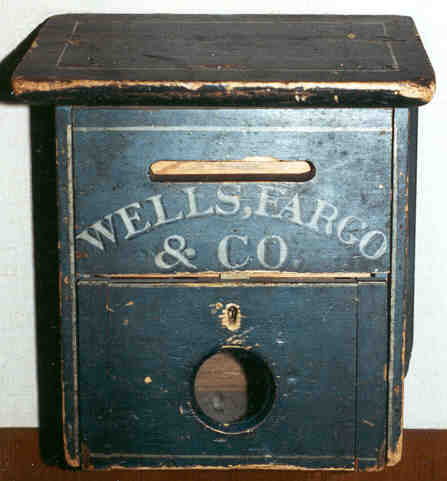
The company ran a lucrative "letter express" business with this green Letter Box,
despite the efforts of the U.S. Post Office to retain its monopoly.
With boxes in every office, in every mining camp, Wells Fargo could easily forward a letter or package to an obsure miner who had "moved on to better diggings."
The only known authentic W.F. & Co. letter box is shown hanging by the saloon's swinging doors in a scene at the end of the 1953 movie,
"Shane," where the gunfight with Jack Wilson takes place. The whereabouts of this Letter Box is not known.
Fast draw HERE!
The company issued many other boxes, including "Old Horse" Boxes, Messenger's Kit Trunks, and Packing Trunks, to name a few.
A Railway Express Agency "Kit Box," c1930, is For Sale.
Call Cards:
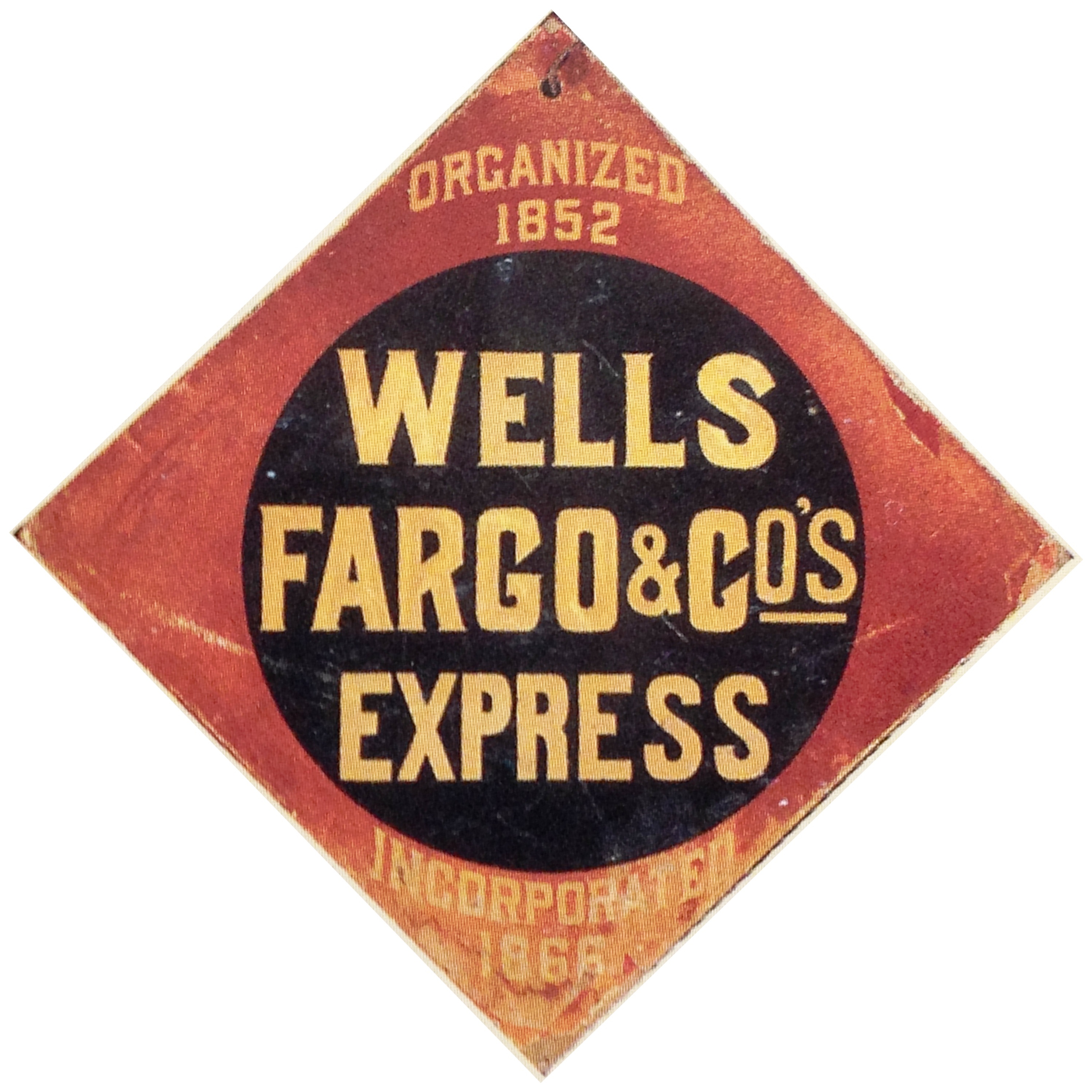 Frequently called "cardboard signs," Call Cards were used by the merchants and regular customers, rather
than by the express office. When the packages were ready for shipment,
the customer would simply hang the call card outside on a nail, or in his shop window. This signaled the express driver to stop and "call" on the customer.
Frequently called "cardboard signs," Call Cards were used by the merchants and regular customers, rather
than by the express office. When the packages were ready for shipment,
the customer would simply hang the call card outside on a nail, or in his shop window. This signaled the express driver to stop and "call" on the customer.
While on their regular "freight runs," express company drivers and messengers would see the call card, call on the customer, pick up the packages, and return the call card to the customer.
Call cards were used as early as 1880, with newer versions issued in 1888, 1898, 1911, 1912, and 1913. The call card pictured here was issued in 1888.
Other signs are discussed in this Museum. Click
Here!
Cap Badges:
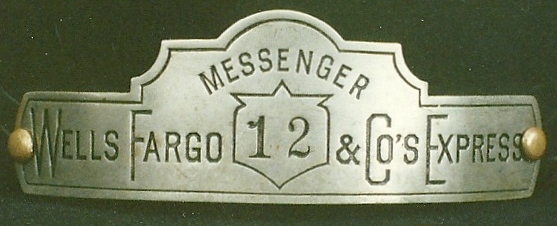
Engraved, "German-silver" Cap Badges (top left) began appearing in the 1870's. In the summer heat, the seven-inch badges were too hot, so they were replaced
by the cooler embossed badges shown at lower left.
The number on the cap badge matched the number on the Messenger's Seal. Messengers were known, and their work recognized by their unique number.
Very few Cap Badges and their corresponding Seals are ever "paired up."
View this rare example For Sale,
or read about the Number 12 Sealer!
Employees used used regular brass paper fasteners to attach the cap badge to the cap. The fasteners on the back of the embossed cap badges did not last, so most employees punched holes
in them and used the customary brass paper fasteners.
Agents, Drivers, Messengers, Porters, and Transfer clerks needed to be identified, because they constantly came into contact with the public.
Each one of these employees was issued a numbered badge. Therefore, the lower the number, the earlier the date of issue.
In 1888, three company departments were established, so a letter prefix was added to the number: "P", "C", and "A" for Pacific, Central, and Atlantic Departments, respectively.
Catalogues:
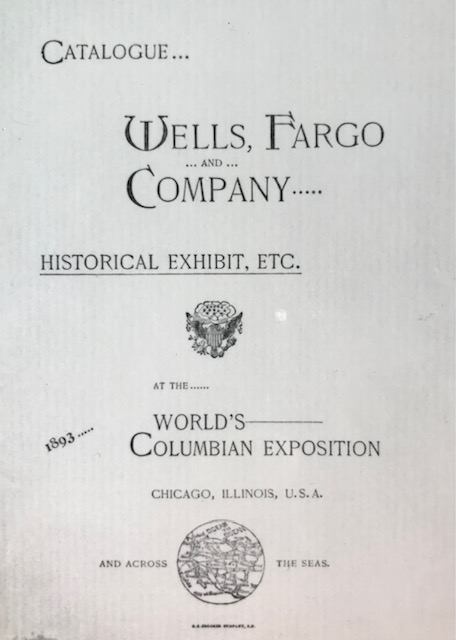
The company was well-represented at the 1893 World's Columbian Exposition in Chicago, honoring the 400th anniversary of the discovery of
America by Columbus.
An olive-green or brown booklet of company historical items that were on display at the Exposition was given to each visitor.
The "Historical Exhibit, ETC." Catalogue listed 172 items of early company property, numbered one through 41, and 42 through 173.
For some reason, number 42 is missing.
Its pages revealed a broad sample of historical artifacts, all of which are avidly sought by collectors and historians today.
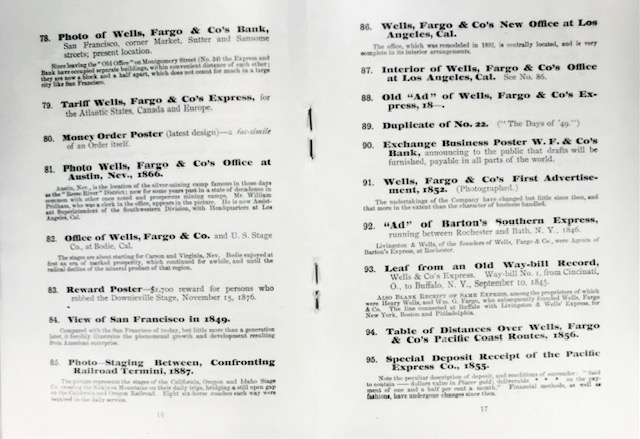
Would you like to read descriptions of the magnificent items in this Catalogue? Click
Here!
Directories:
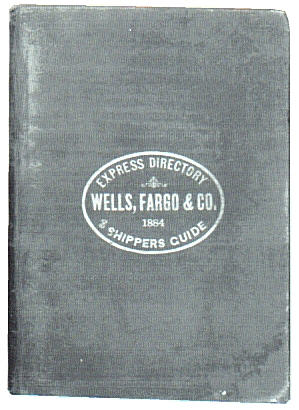 Directories were tables of destinations and other information needed by the agent to properly route all express business. Earlier "directories" were
simply alphabetical Lists of Offices, but later editions began to use destination codes.
Directories were tables of destinations and other information needed by the agent to properly route all express business. Earlier "directories" were
simply alphabetical Lists of Offices, but later editions began to use destination codes.
Express company destination codes, refined later by the American Railway Express Co. and the Railway Express Agency, were the forerunners
of the modern-day Zip Codes and airport codes on airline baggage tags.
Directories were printed thru 1918. To view a 1914 Directory For Sale: Click here!
Firearms:
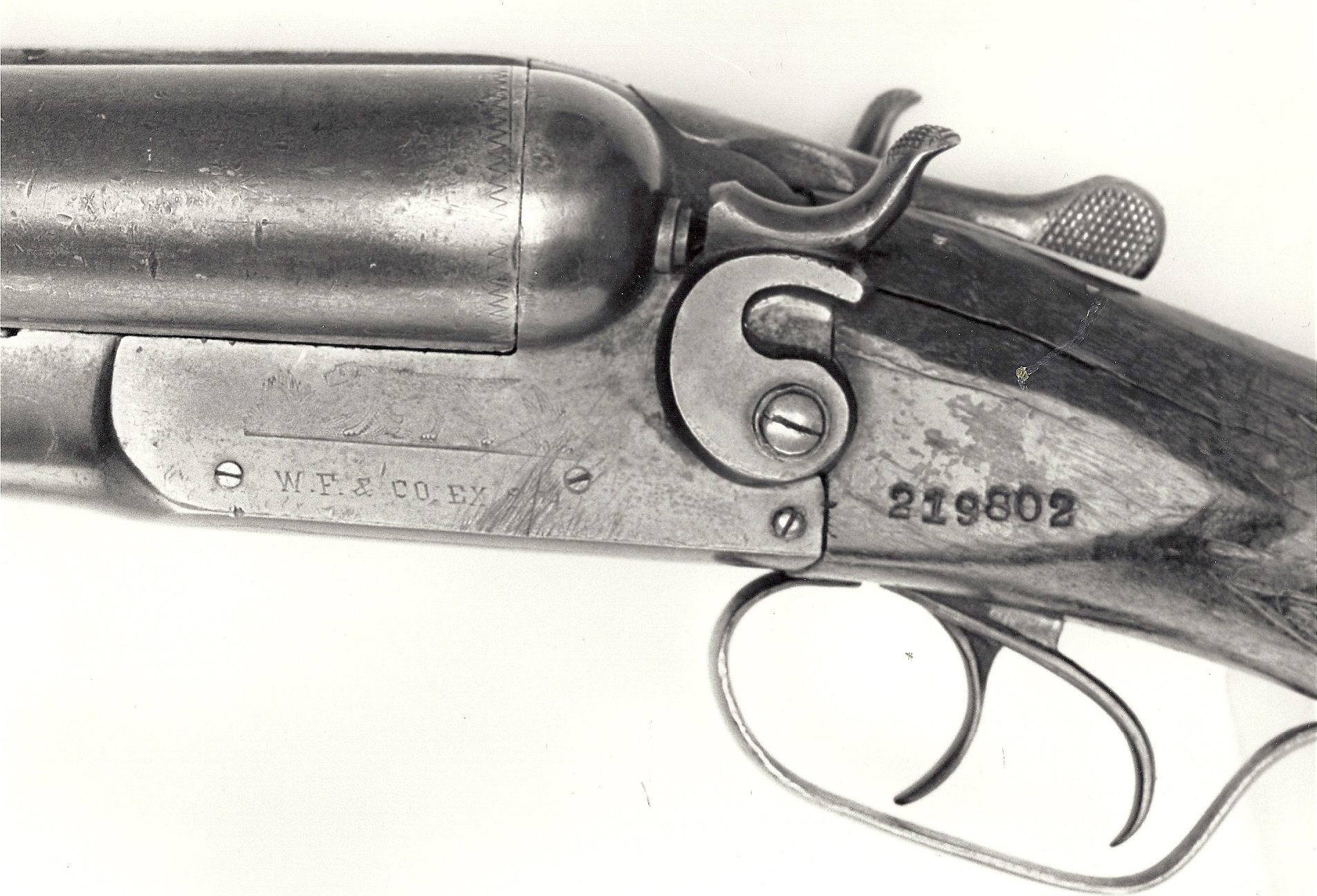 Agents issued one or more firearms to messengers and guards at the start of their "run:" A revolver with belt and holster, a shot gun, and a rifle.
Messengers and guards were responsible to check them to be clean and operational, and to load them with the ammunition provided by the agent.
Agents issued one or more firearms to messengers and guards at the start of their "run:" A revolver with belt and holster, a shot gun, and a rifle.
Messengers and guards were responsible to check them to be clean and operational, and to load them with the ammunition provided by the agent.
This Ithaca double-barrel 12-gauge shot gun, serial number 219,802, was typical of the major firearm used by Messengers to protect
the shipments of gold, coin, and valuables. While most early shot guns were engraved with the company name between the barrels,
this one was engraved on the trigger housing.
 Wood stocks were replaced easily, so the company did NOT mark its name on the stocks.
Wood stocks were replaced easily, so the company did NOT mark its name on the stocks.
Since the firearms were issued wherever they were needed, locations were NOT marked on any firearms.
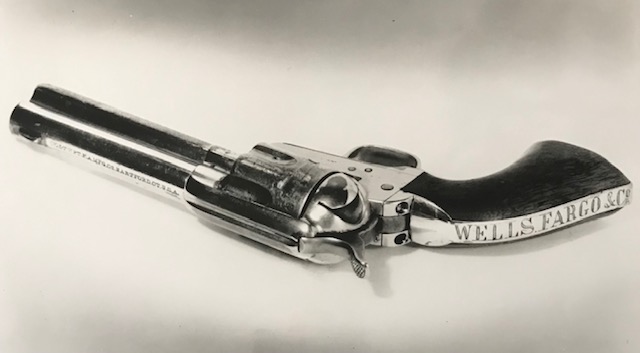
This firearm is related to a famous historical event. Read about it
Here!
Forms:
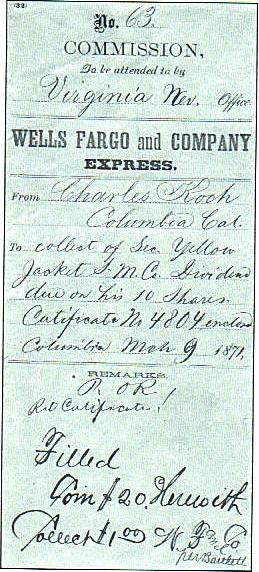
The company used business forms numbered in the hundreds, far too many to be documented here.
There was probably one printed form for every conceivable event in the course of running the business.
Sometimes the form numbers conflicted. Eventually, renumbering the forms caused even further conflicts.
Using this Commission Envelope, Charles Koch, in Columbia, California, is asking the agent in Virginia City, Nevada, to collect a $20.00 dividend
from the Secretary of the Yellow Jacket Silver Mining Company. The agent collected the dividend and retained a $1.00 commission for the company.
The remaining $19.00 was returned to Mr. Koch in the envelope.
Franks:
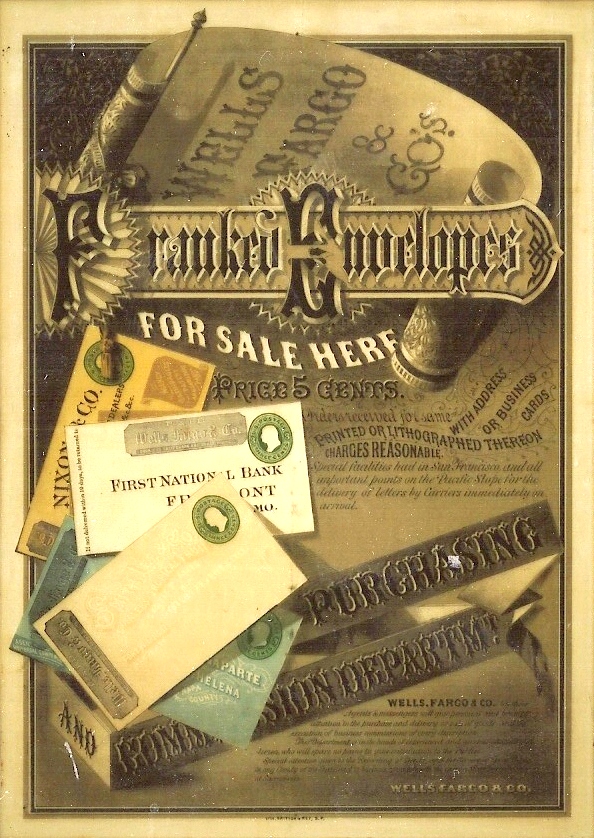 In the latter half of the 19th century, a service that was pre-paid, or performed
free-of-charge by the government or a company was known as a "Frank." Members
of the U.S. Congress had long used the "Franking Privelege" to send official mail to constituents without paying postage.
In the latter half of the 19th century, a service that was pre-paid, or performed
free-of-charge by the government or a company was known as a "Frank." Members
of the U.S. Congress had long used the "Franking Privelege" to send official mail to constituents without paying postage.
Most of the stage and packet lines, railroads, telegraph, and express companies in that period issued one or more types of franks. The franks were gratuities
that were given to business associates and favored customers free of charge, usually in return for similar favors.
Wells Fargo & Co. printed their franks on postal envelopes and sold them at a profit, in return for delivering mail for the government. This exquisite poster advertises this service.
In 1868, Cashier James Heron authorized Agent Daegener in Columbia, Cal. to make rates on postal franks "irrespective of Tariff," in order to retain customers and shut out the competition.
Other types of franks were complimentary Annual Franks and books of gummed Package Franks. These were given to favored customers, such as executives of railroads and packet lines.
GOLD!
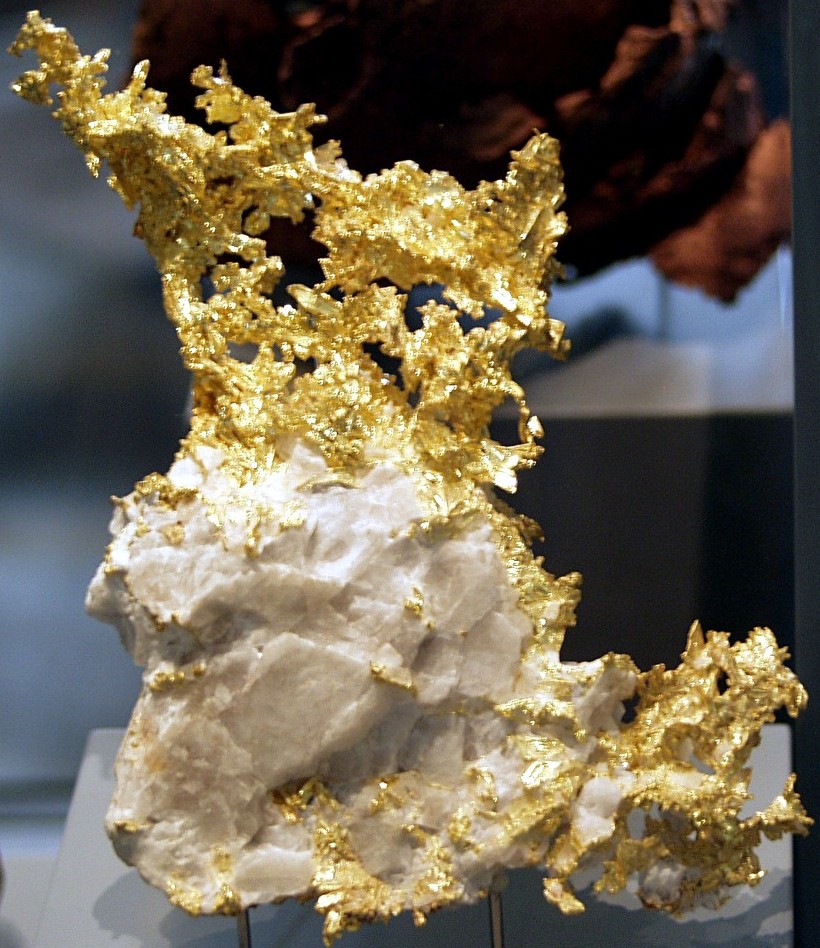 On January 24, 1848, James W. Marshall discovered gold at Sutter's Mill in Coloma, California -- the start of the famous California Gold Rush.
For the next thirty years, hundreds of thousands of gold-seekers poured into California in covered wagons, steamers, and sailing ships.
Gold comes in many forms, and Marshall discovered it in its most convenient one -- he merely picked up a handful of gold "nuggets,"
which were readily visible in the mill race.
On January 24, 1848, James W. Marshall discovered gold at Sutter's Mill in Coloma, California -- the start of the famous California Gold Rush.
For the next thirty years, hundreds of thousands of gold-seekers poured into California in covered wagons, steamers, and sailing ships.
Gold comes in many forms, and Marshall discovered it in its most convenient one -- he merely picked up a handful of gold "nuggets,"
which were readily visible in the mill race.
Two other forms are gold "quartz" and "dust." Gold quartz was a fusing of the metal with hardened silicon -- it had to be mined and "picked" out of the dark and damp spaces
in "diggings" that the miners carved into the hills of the Sierra Nevada mountains.
Gold dust was a sand-like accumulation of grains that had to be "panned" from the rivers and streams. Thus, the advent of the "pick and pan peddlers" that set up shop
and sold the tools at exorbitant prices to the would-be gold-seekers.
The image shown here is from Wikimedia Commons. Additional fine examples of gold nuggets and gold quartz can be seen on various websites, such as
Nevada Outback Gems.
Exquisite examples of placer gold nuggets are on display at the Wells Fargo History Museums in
San Francisco and
San Diego
California.
NOTE: On these websites, wait for the images to be displayed, then "page through" the images until the gold nuggets are displayed.
For additional history and details of the California Gold Rush, be sure and visit the Wikipedia website.
Highwaymen:
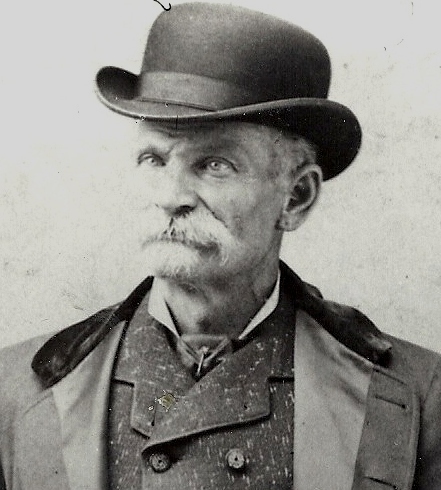 In the Old West, robbers, outlaws, and bandits were known simply as "Highwaymen." While many of these men were noted for their daring
and violence, one man stands out aove all the rest.
This photo shows the gentle soul, Charles E. Boles, whom we all know today as "Black Bart." He enjoyed the finer things of life at the
expense of Wells Fargo & Co.'s Express.
He considered it his duty to convince the stage coach's Wells Fargo messenger to give up the green treasure box.
He was a poet at heart, and he left this poem at one of the robbery sites:
In the Old West, robbers, outlaws, and bandits were known simply as "Highwaymen." While many of these men were noted for their daring
and violence, one man stands out aove all the rest.
This photo shows the gentle soul, Charles E. Boles, whom we all know today as "Black Bart." He enjoyed the finer things of life at the
expense of Wells Fargo & Co.'s Express.
He considered it his duty to convince the stage coach's Wells Fargo messenger to give up the green treasure box.
He was a poet at heart, and he left this poem at one of the robbery sites:
"here I lay me down to Sleep -- to wait the coming morrow
perhaps Success perhaps defeat -- and everlasting Sorrow
I've labored long and hard for bread -- for honor and for riches
But on my corns too long you've tread -- you fine haired sons of bitches
let come what will I'll try it on -- my condition can't be worse
and if there's money in that box -- Tis munney in my purse
- - Black Bart, the Po 8"
Read an excellent (Wikipedia) account of his life and robberies: Click here!
(Notice the locations of his first and last holdups!)
Horses:
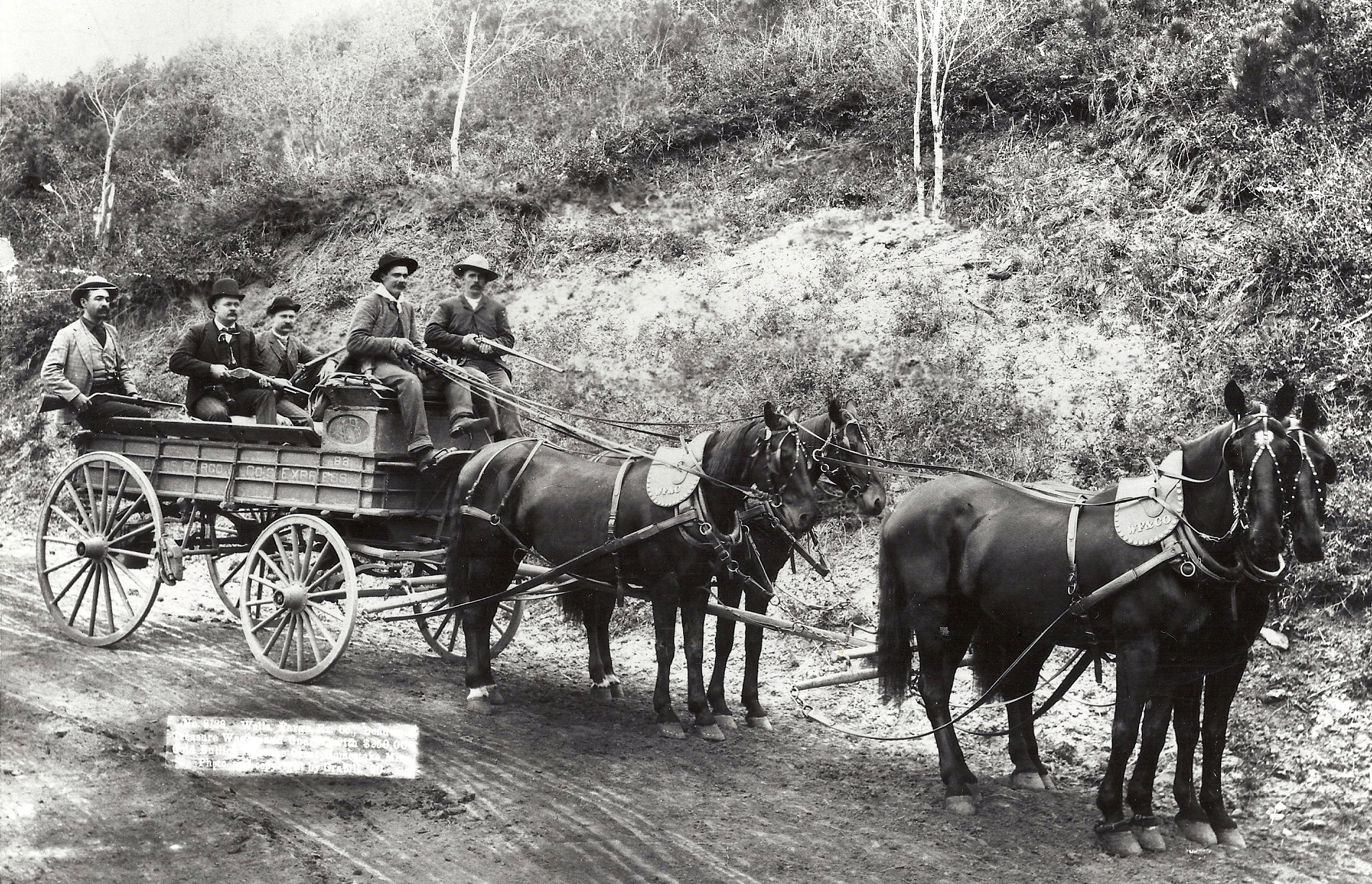 The company loved its animals!
Since the company needed horses to transact business, myriad items were purchased
by each office to meet the needs of the animals.
Nose bags, bits, blankets, bobs, breast plates, bridles, harnesses, fly nets, mane brushes, collar pads, combs, hoof oil,
hitch weights, storm covers, and terrets are just a partial list of the required items.
The company loved its animals!
Since the company needed horses to transact business, myriad items were purchased
by each office to meet the needs of the animals.
Nose bags, bits, blankets, bobs, breast plates, bridles, harnesses, fly nets, mane brushes, collar pads, combs, hoof oil,
hitch weights, storm covers, and terrets are just a partial list of the required items.
Within the company, only the male animals were called "horses." The females were always called "mares." Whenever possible,
horses and mares were always harnessed to wagons and stage coaches in "matched pairs." They were fed every morning, noon,
and night -- 4-6 quarts of oats per meal, and 10-15 pounds of hay per day.
Enjoy a few minutes with a lady who loves her Wells Fargo horses! Click here!
Very few artifacts relating to the company's horses have survived.
This Horse Blanket is a survivor, but its buckles and straps have been removed.
Blankets were used along the Messenger's run, as well as in the stable.
Lamps & Lanterns:
The agent at Ardmore, Indian Territory (now Oklahoma) purchased a "lamp" in 1894 for $0.20, and classified it as "Office Property."
He purchased a "desk lamp" in 1899 for an unspecified amount. So far, no authentic Wells Fargo & Co. lamps or desk lamps have ever been found.
Authentic kerosene lanterns, on the other hand, are plentiful. These lanterns were purchased from many of the railroad supply houses and manufacturers,
such as Adams & Westlake, M.M. Buck, and Handlan, Inc.
"Wire Cage" lanterns used one or two heavy horizontal wire rings to protect the globe, with an additional wire ring forming the top
of the cage, and still another forming the bottom.
The globes were always clear, and often etched or embossed with the company's initials.
This lantern is an excellent example -- manufactured by Star Headlight Co., with an embossed clear globe.
Lists:
In 1852, a List of Offices was merely an advertising "broadside" that was printed, framed, and posted in each express office.
The 1857 a "List of Offices & Agents" boasted 78 offices, employing a total of 320 employees.
In 1859, the company had expanded to 102 offices and agents, all of which were mentioned
on this Offices" list from OldWestAntiques.
At some point, probably in the 1870's, the "List" became a "Directory," and was published in book form.
Agents' names were omitted after 1911.
Locks & Keys:
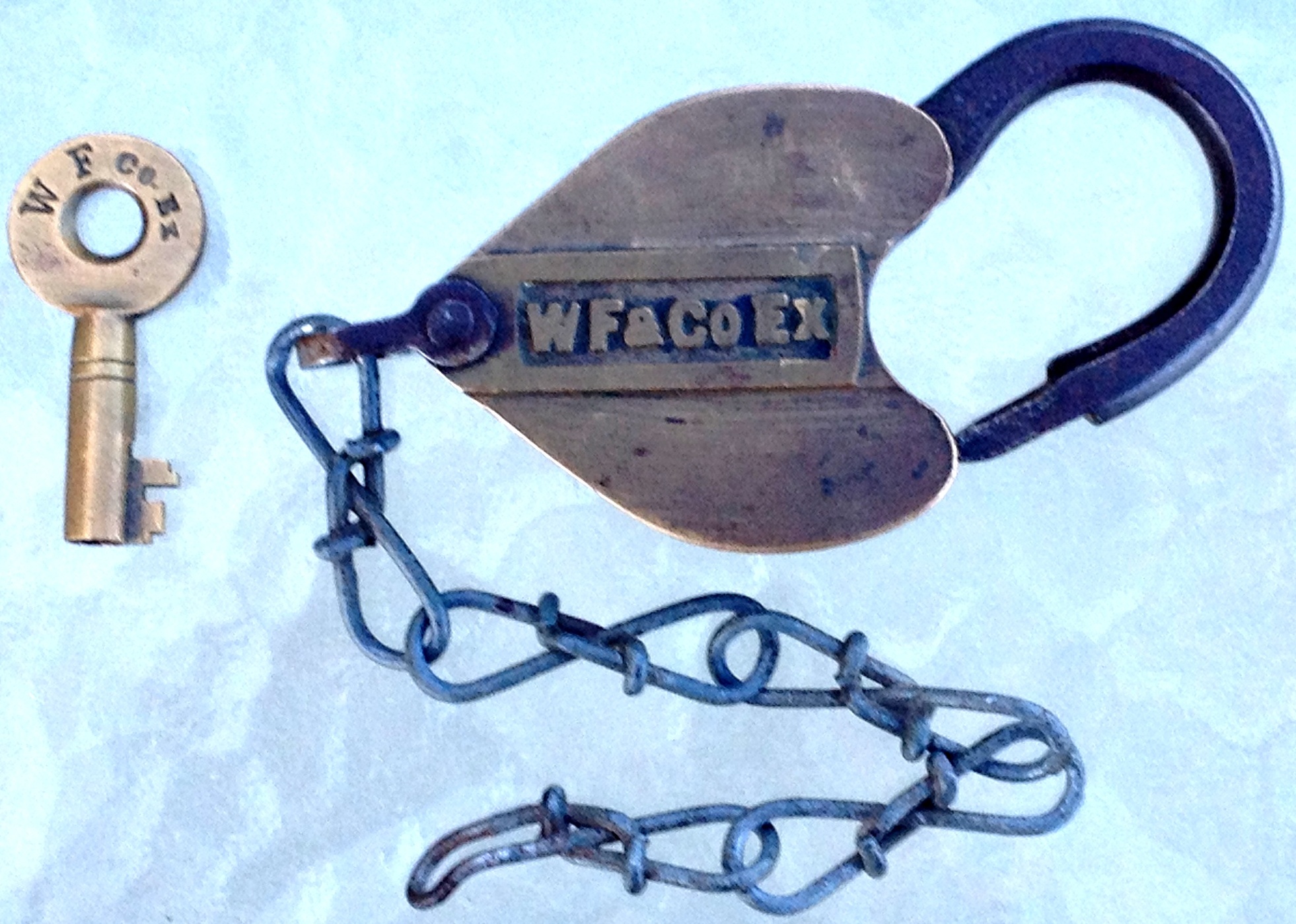 Locks & Keys of various types were used to lock office doors, treasure boxes, kit trunks, express cars, day wagon cages, and office cages.
Locks & Keys of various types were used to lock office doors, treasure boxes, kit trunks, express cars, day wagon cages, and office cages.
Ayers, Climax, and Romer are the common manufacturers that assembled the locks from either malleable iron or brass parts.
Note the missing "&" on the key shown here -- a very rare error.
Instruction #18 from the 1884 Book of Instructions bears witness to the high value placed upon keys within the company:
"Losing a key, or forwarding a treasure box unlocked, will not be excused."
This lock has an "integrated" locking mechanism, which dates back to 1871: It requires a turn of the key to close the lock. The "modular"
locking mechanism merely requires the shackle to be pressed firmly into the body to close the lock.
Medals:
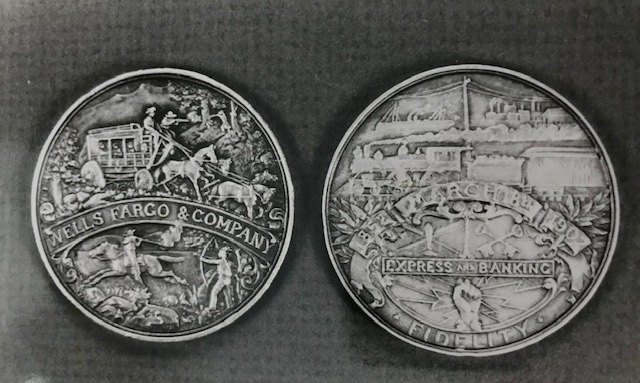
A Semi-Centennial Medal was struck out of coin silver in 1902, in commemoration of the 50th anniversary of the founding of the company.
The medal's box was maroon, and lined in blue belvet. The president of the company, Dudley Evans presented the Medal and Box,
along with a letter, to 5,000 employees with at least one year's service.
Photos:
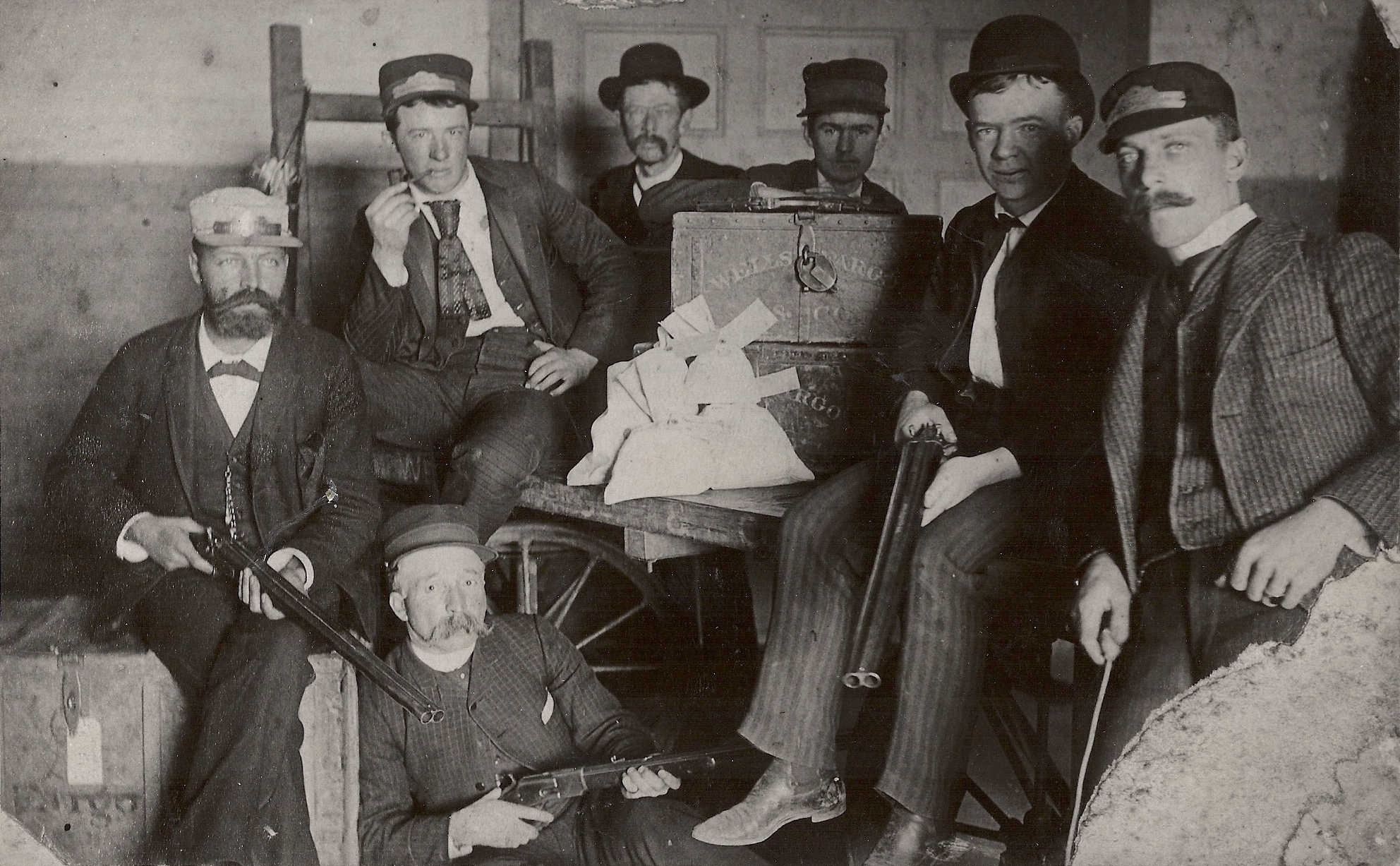 Photography was still in its infancy in the early years of the company. However, the expressmen, their offices, and the stage coaches
and wagons upon which they rode, captured the attention of enough photographers to record for us a few moments in the livea of the agents and messengers.
Photography was still in its infancy in the early years of the company. However, the expressmen, their offices, and the stage coaches
and wagons upon which they rode, captured the attention of enough photographers to record for us a few moments in the livea of the agents and messengers.
This photo shows messengers in the Reno, Nevada office around 1880, with their shot guns, coin bags, and treasure boxes. The messenger on the far right
holds a cord that is attached to the camera's shutter, allowing him to take a "selfie" with his friends.
An early Carleton E. Watkins photograph of San Francisco harbor is available: Click here!
Reward Posters:
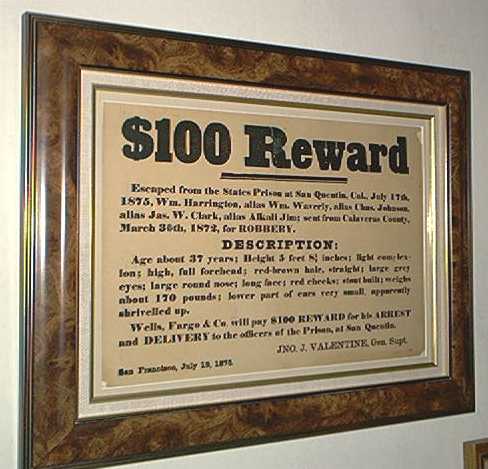 The company offered Rewards for the capture of Highwaymen, who constantly robbed Offices and Stagecoaches. Rewards often exceeded $2,000,
and a portion of the recovered treasure frequently was paid in addition to the posted amount.
The company offered Rewards for the capture of Highwaymen, who constantly robbed Offices and Stagecoaches. Rewards often exceeded $2,000,
and a portion of the recovered treasure frequently was paid in addition to the posted amount.
In 1873, a $10 Reward was posted for "Club Foot Jake."
In 1877, a Standing Reward of $300 was offered for the arrest and conviction of any Highway Robbery. This marked the end of printing posters for
many individual robberies.
In 1893, a $10,000 Reward was offered for the arrest and conviction of Chris Evans and John Sontag.
Scales:
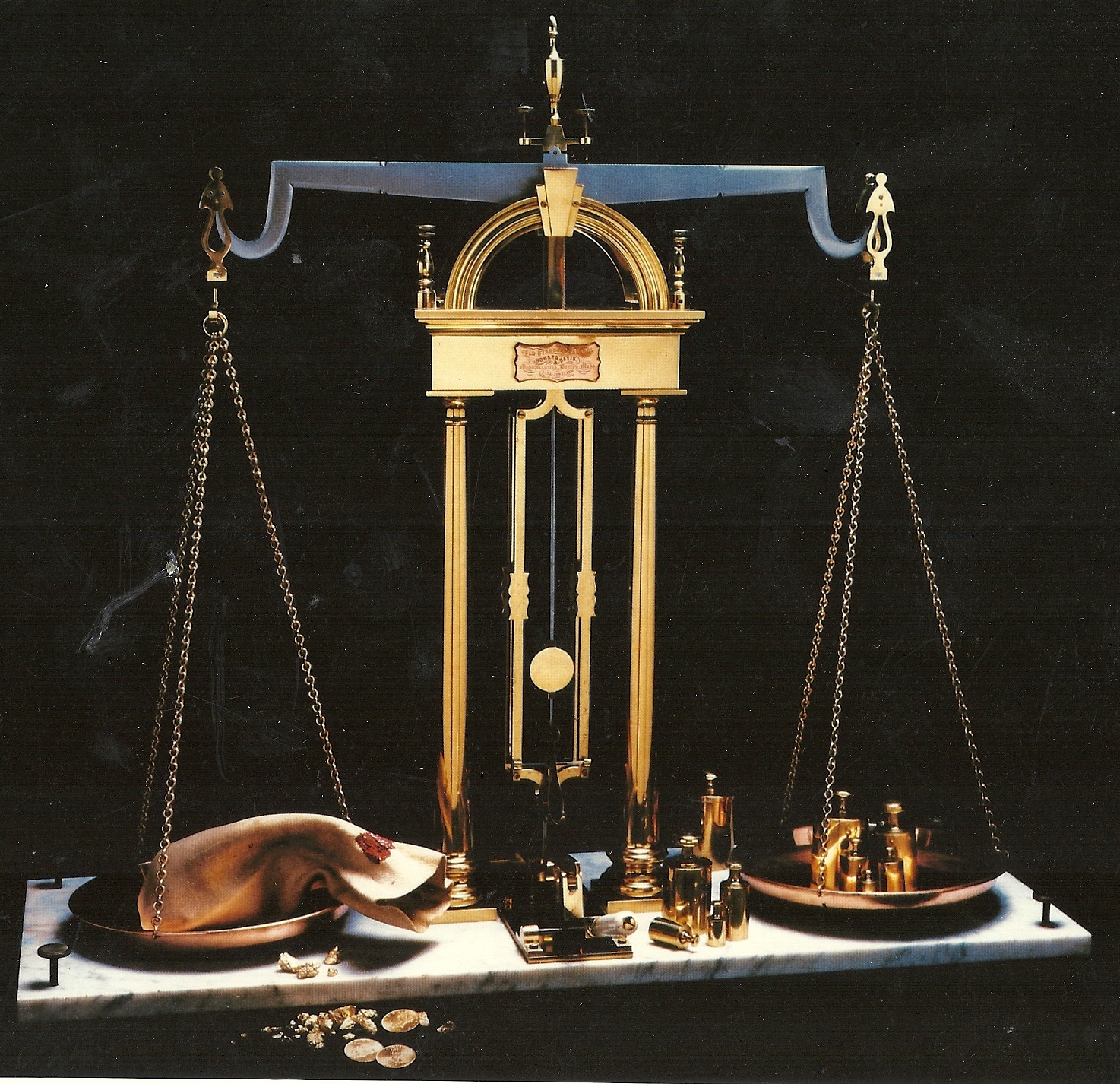 The gold scale was the most important instrument in the gold country. It established a fair return to the miners for the grains of gold dust
that had been extracted painfully from the streams and rivers.
The gold scale was the most important instrument in the gold country. It established a fair return to the miners for the grains of gold dust
that had been extracted painfully from the streams and rivers.
Howard & Davis manufactured this scale in Boston, and it became the standard for Wells Fargo & Co. When he saw his dust being weighed,
each miner knew that he was getting a fair value from Wells Fargo.
First, the scale was leveled and the beam was balanced. The pans were cleaned and allowed to hang freely until the pointer was zeroed on the scale.
Then, the arrester stabilized the pans and the gold dust was poured onto one pan.
Weights were placed upon the other pan and the arrester released the pans. Weights were
added or removed until the pointer once again was zeroed on the scale.
At that time, the weight was noted, and the miner was paid the proper amount, either in gold coins, in credit to his account, or with a
Bill of Exchange, to be mailed back East to his family.
The Howard & Davis gold scale was so accurate that pencil marks on a waybill were enough to upset the balance of a blank waybill.
(Photo courtesy of Wells Fargo Bank)
Seals & Sealers:

For centuries, seals have been used to ensure that the contents of an envelope or
package would reach its addressee, uncompromised, and unaltered by the carrier.
A seal, therefore, is a device that is unique, is affixed by the
sender, is easily recognized by the addressee, and is difficult, if not
impossible, to duplicate.
These two fine seals represent thousands of similar seals issued by the company. In this case, Seal #12 was issued to a Messenger, along with a Cap Badge with the same number.
The number on the Messenger seal matched the number on the Messenger's Cap Badge.
Very few Cap Badges and their corresponding Seals are ever "paired up."
View this rare example For Sale,
or read about the Number 12 Cap Badge!
The Seal on the right is an "Office Seal," and was issued to the agent at Oroville, California.
These photos were taken with the seals next to mirrors in order to reflect the Seals' impressions in the photographs. In addition, kitchen flour was impressed into the Oroville sealer to show the lettering. Today, seals are commonly called "wax sealers."
Unfortunately, "wax sealers" are duplicated easily in today's machine shops,
resulting in making many of today's so-called "Wells Fargo wax sealers" suspect.
Besides the messenger and office seals, the company issued "lead & wire" seals and sealers for locks, and Porter Bag Sealers with "lead and twine" seals for coin bags.
Signs:
After the stagecoach, the treasure box, and the shotgun, the wood sign is probably the most enduring symbol of the
presence and influence of the company in the American West.
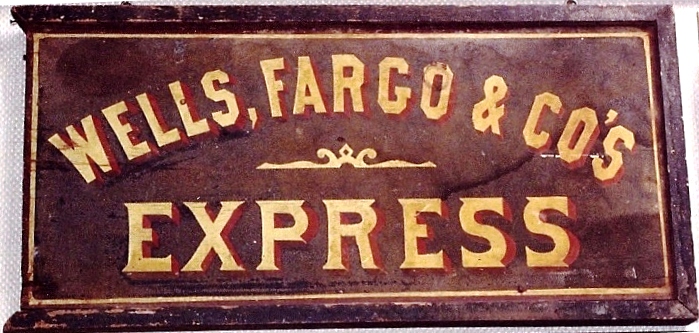 The sight of a wood sign being nailed to the front of an office announced
that a remote mining camp had attained significant status.
The sight of a wood sign being nailed to the front of an office announced
that a remote mining camp had attained significant status.
The sign placed the miners and merchants in communication with the rest of the world -- they could
anticipate more than just an ephemeral gold-strike volume of business in the future.
Enamel and cardboard signs were also widely used. The 1898 and 1913 enamel double face Office Signs are shown below at left.
The cardboard Call Cards shown at right are from 1880 and 1911.
Call Cards are discussed further in this Museum. Click
Here!


"Blue and White" signs were numerous, both as Office Signs and for Money Order sales. The two signs on the left are enamel,
and the one on the right is cardboard.



Stationery Cases:
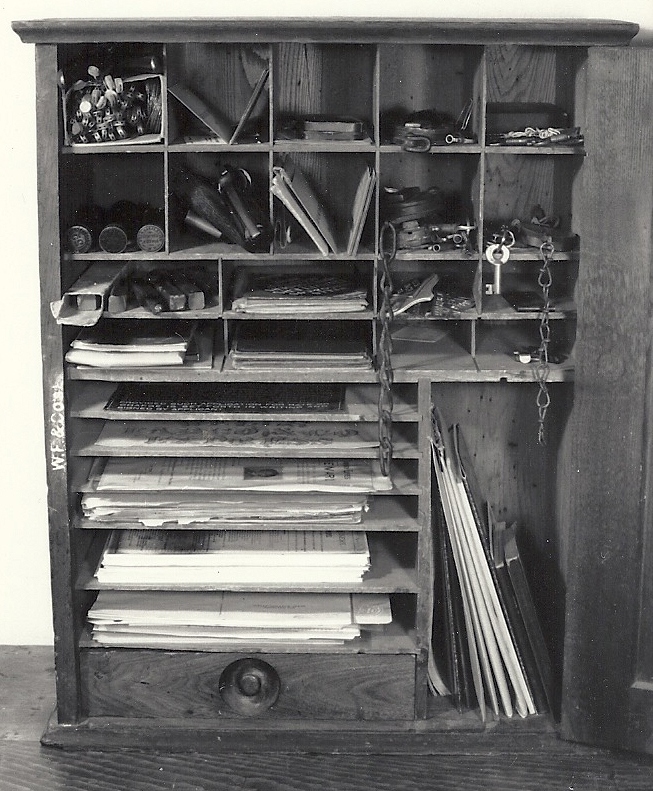
Every office had an oak Stationery Case, consisting of a door and lock, a drawer, and about two dozen cubicles of varying sizes.
The case was indispensable to the efficient running of an office. It stored blank forms, rate books,
labels, seals and sealing wax, plus all of the papers needed to conduct business.
Stereographs:
Stereographs often document places and events about the company that would otherwise be lost to time.
This view, published by the famous Lawrence & Houseworth company, depicts two stagecoaches getting ready to leave Virginia City, Nevada in 1865.
The coaches are on C Street, in front of the office of Shaw's Fast Freight Line, carrying Great Overland Mail and Wells, Fargo & Co.'s Express
to San Francisco and Sacramento.
Trucks & Wagons:
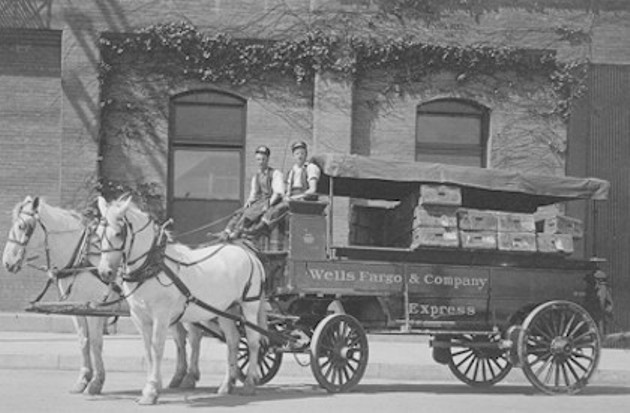 Two-wheeled hand trucks were used for moving heavy trunks and crates.
Two-wheeled hand trucks were used for moving heavy trunks and crates.
Four-wheeled trucks and wagons included single wagons, day wagons, double wagons, cage wagons, and mud wagons, each of which had its specific use.
This photo shows a driver and messenger on their daily "rounds" on a "fifth wheel" day wagon. The fifth wheel was mounted horizontally
underneath the driver and messenger, attached to the front axle. It allowed a vastly improved turning radius for the day wagon.
Notice that the horses pulling the wagon are "matched pairs," a company rule that was followed wherever possible.
Wagon Banners:
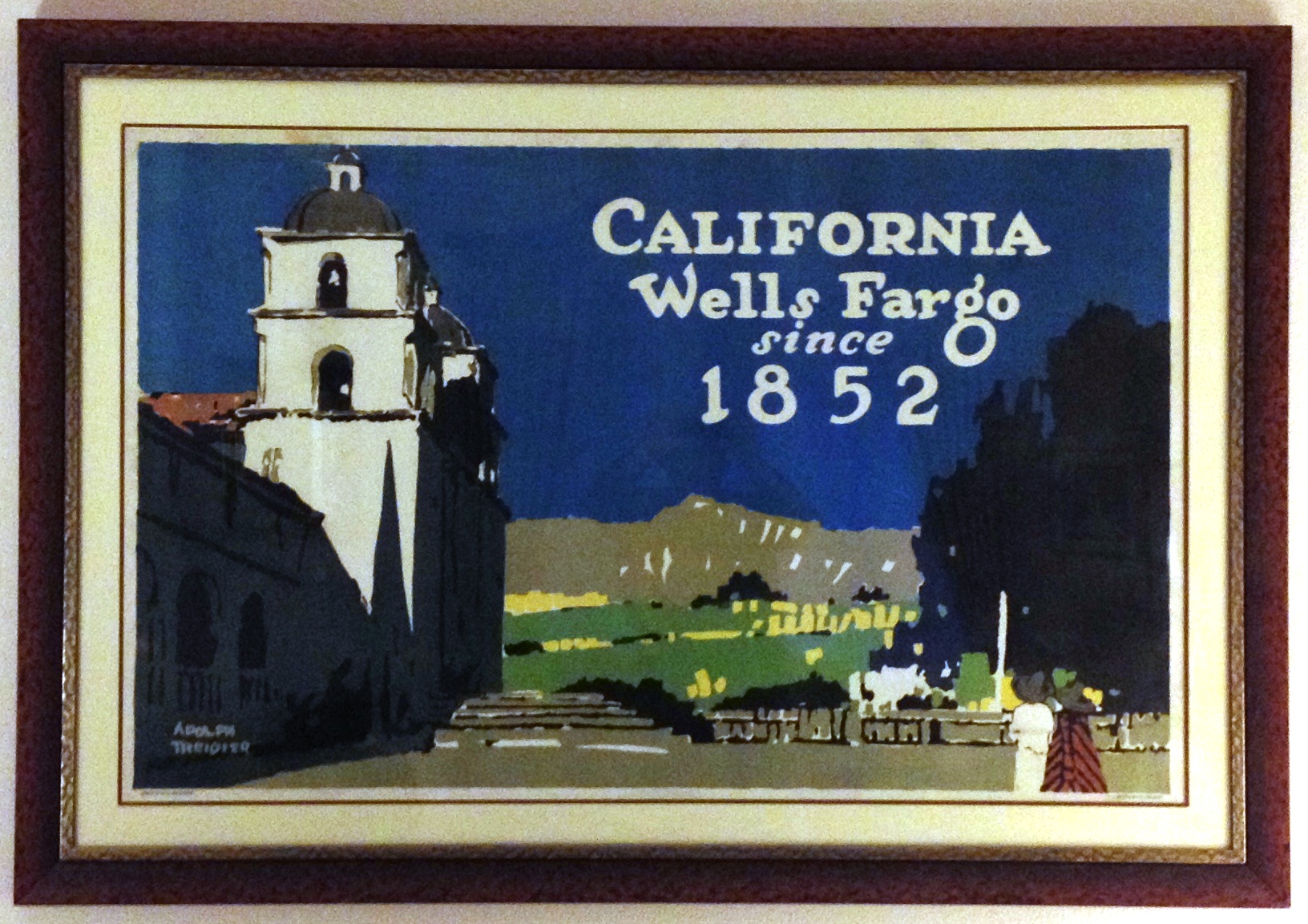
Wagon Banners like this were pasted on the sides of Wells Fargo "Day Wagons," much like pasting bills on billboards.
These banners were replaced virtually every month! Therefore, very few have ever survived.
Wagon Banners measure about 55-inches wide by 35-inches high.
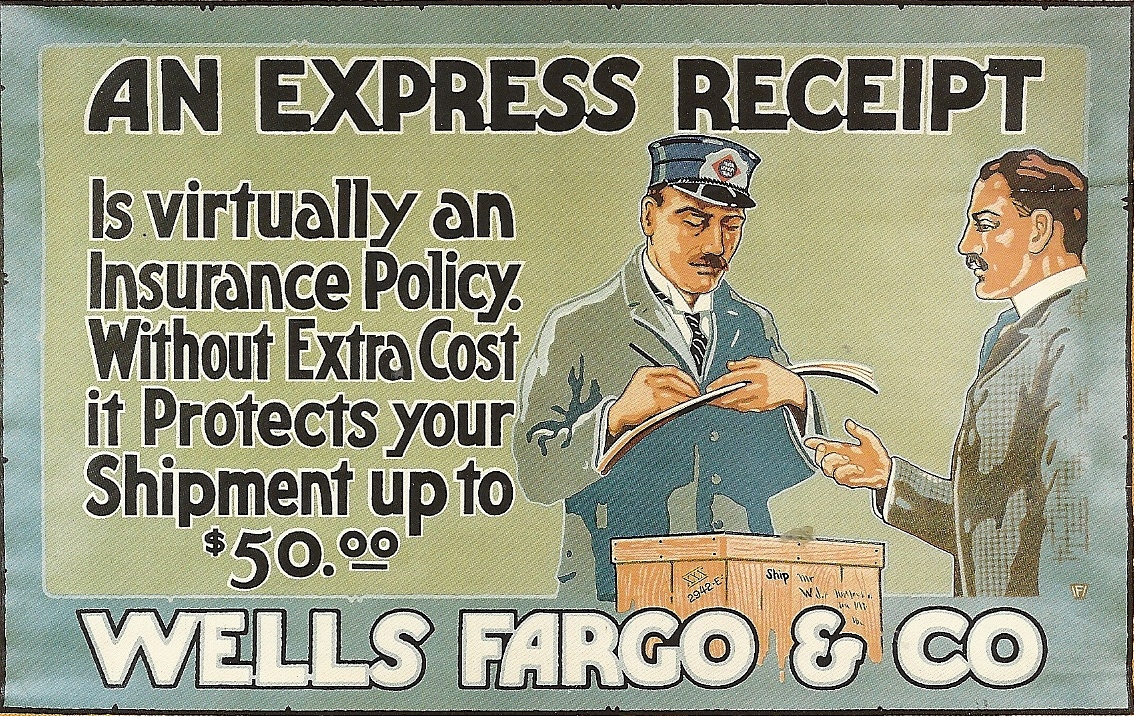
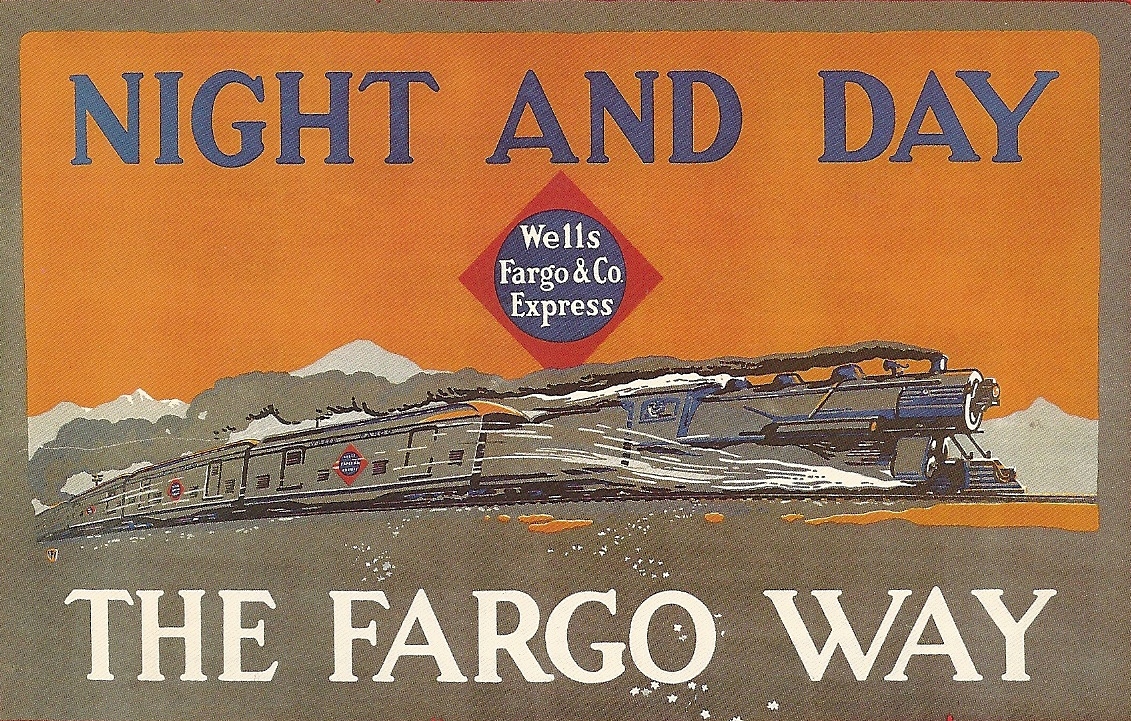
Watches:
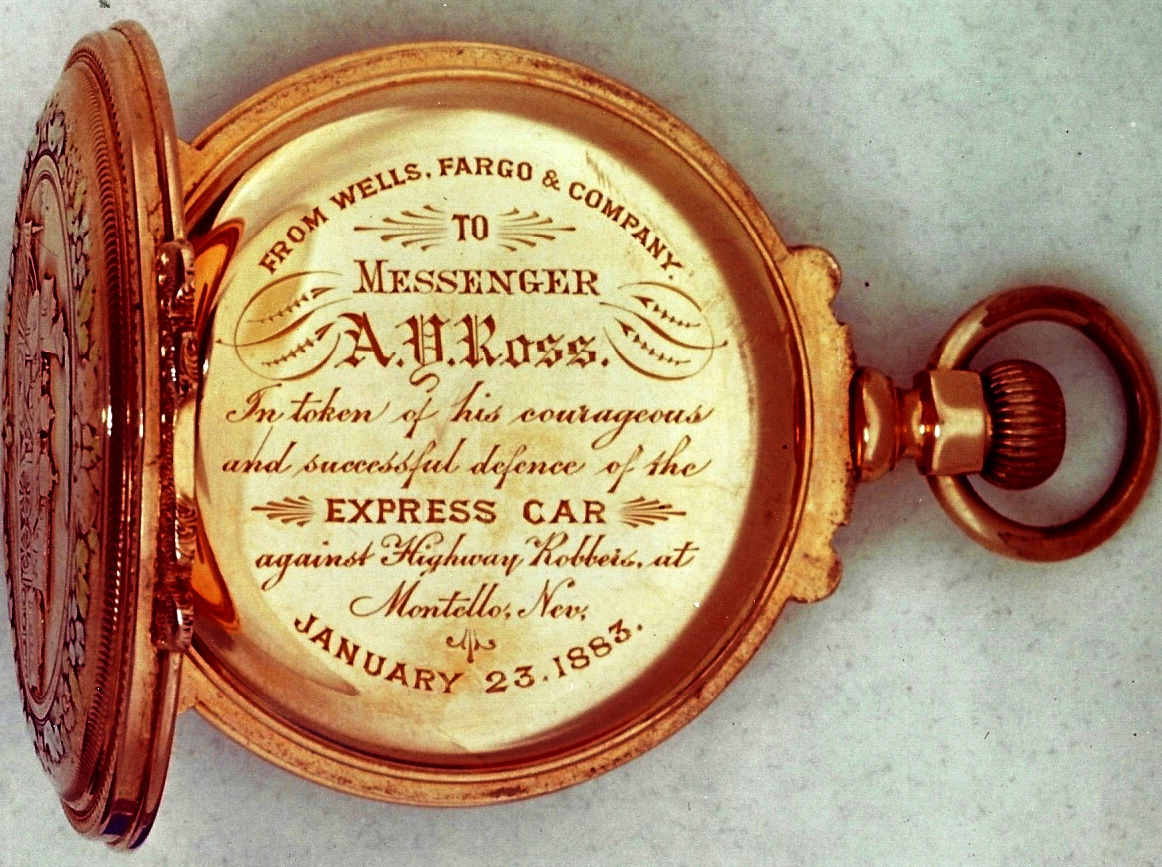 Wells Fargo & Company presented fine watches to messengers who performed meritorious service.
Wells Fargo & Company presented fine watches to messengers who performed meritorious service.
As an example, Messenger Aaron Y. Ross defended $60,000 in coin from highwaymen, and received this watch from a grateful company.
At Montello, Nevada in 1883, for 3-1/2 hours, Ross fended off repeated attempts to rob the Wells Fargo & Co.'s Express car on a Central Pacific Railroad passenger train.
He killed one bandit, wounded several others, was himself wounded three times, and survived the ordeal!
Charles Crocker, head of the Southern Pacific Company, paid for Ross' medical recovery. Wells Fargo presented Ross with this watch and a check for $1,000.
One thousand dollars in 1883 is worth about $24,000 today.
 Oh, by the way: Ross was left-handed, and he used this Colt single-action .45 caliber revolver.
Oh, by the way: Ross was left-handed, and he used this Colt single-action .45 caliber revolver.
In the year following the robbery, Mrs. Ross presented him with a baby girl, whom he named "Montello."
Would you like to read the details about the robbery?
Click here!
. . . and,
Here!
Other firearms are presented in this Museum. Click
Here!
Call: 951-404-3069
Email: [email protected]
© Copyright 2022 The Westbound Stage® - All rights reserved.